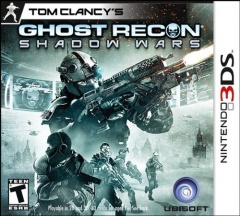terrorists
Tom Clancy's Ghost Recon: Shadow Wars
 Very few titles available at a system's launch are ever worth the price
of admission. Thing is, they don't have to be: early adopters don't have
any other choices, and they certainly aren't taking home that shiny new
box with nothing to play. If a launch window game isn't a glitchy,
feature-stripped port of a last-gen game, then it may just be the best
of the bunch.
Very few titles available at a system's launch are ever worth the price
of admission. Thing is, they don't have to be: early adopters don't have
any other choices, and they certainly aren't taking home that shiny new
box with nothing to play. If a launch window game isn't a glitchy,
feature-stripped port of a last-gen game, then it may just be the best
of the bunch.
Ubisoft in particular doesn't have a great track record when it comes to launch games. They were the first third party to reveal their Wii hand with the ambitious and roundly disappointing Red Steel, threw straight up shovelware at the DS, and didn't exactly set any precedents at the dawn of the HD era, either. For the 3DS, Ubi's launch day contributions took the forms of Rayman 3D, Asphalt 3D, Combat of Giants: Dinosaurs 3D, and Ghost Recon: Shadow Wars.
It doesn't surprise me, then, that Ghost Recon: Shadow Wars is a technical mess. The visuals wouldn't turn heads on PSP, slowdown is common, and everything just feels rough around the edges. Oh, and then the game freezes every now and then. Sometimes you'll get the black screen of death, other times the audio will stop and the display will just fade out. In the time I was playing, Shadow Wars crashed on me a grand total of ten times.
What surprises me is that, despite these glaring technical issues, I will still recommend the game to 3DS early adopters.
Black
 When I think back to the first time I saw Sonic the Hedgehog running on
the Genesis (which I wasn't yet familiar with), I recall marveling at
how much better it looked than the Mario games I had at home. I remember
the time my brother tried to explain Super Mario 64 to me, and how
little I understood what he was saying until I finally witnessed it in
action. When I brought home a Gamecube the morning it launched, I was
impressed with the speed and fluidity of the Death Star trench run that
began Rogue Leader, at least when compared to its predecessor on the
N64. But the first time I saw Call of Duty 2 at Toys R Us on an HDTV
screen, the only thought that ran through my mind was...
When I think back to the first time I saw Sonic the Hedgehog running on
the Genesis (which I wasn't yet familiar with), I recall marveling at
how much better it looked than the Mario games I had at home. I remember
the time my brother tried to explain Super Mario 64 to me, and how
little I understood what he was saying until I finally witnessed it in
action. When I brought home a Gamecube the morning it launched, I was
impressed with the speed and fluidity of the Death Star trench run that
began Rogue Leader, at least when compared to its predecessor on the
N64. But the first time I saw Call of Duty 2 at Toys R Us on an HDTV
screen, the only thought that ran through my mind was...
"Really? This is next-gen?"
Yes, the characters were constructed of more polygons. And the textures were clearer. And of course, the higher resolution made everything easier to see. But I just couldn't help but feel a little disappointed, seeing that the the game, and others in the 360 launch library, just didn't seem to bring any worthwhile improvements to the table. In fact, it wasn't until the first time I saw Lost Planet's smoking RPG trails, gorgeous boss monsters, and swarms of flying enemies that the feeling of a new generation really sank in.
On the other hand, many quality games are released at the end of a console's life cycle, once developers have a firmer grasp on the intricacies of the hardware. It is unfortunate that they're often overlooked for the next console's rushed launch titles, but that's reality. EA's Criterion studio, creators of the high-octane Burnout series, attempted to buck that trend with Black, a first-person shooter for the PS2 and Xbox that was marketed as a next-gen shooter for current-gen platforms.
The game certainly looked impressive the first time I saw a friend playing it, some five years ago. Does it still pack a punch, or will Black forever be lost between generations?
